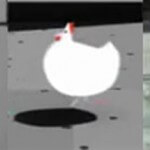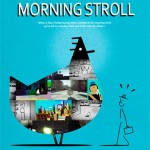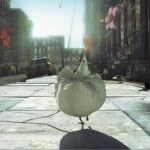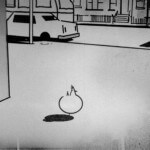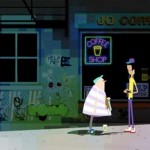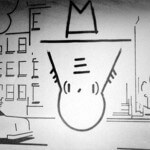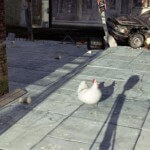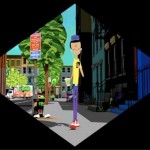Interview: Studio AKA’s Grant Orchard On “A Morning Stroll”
 Studio AKA has a long-standing tradition of high-calibre output in the world of animation and motion graphics, from short films to colossal advertising campaigns. Recently, AKA Designer and Animation Director Grant Orchard (known for his viral hits ‘Park Foot Ball’ and ‘Paintballing’ among others) finished ‘A Morning Stroll’, a two-year labour of love produced without funding within the walls of Studio AKA when time presented itself. Partly inspired by a true story, the film re-enacts the same turn of events in three different eras and visual styles – the jaunty, rubberhose period of the early twentieth century; our current design and technology conscious age; and a lavish, CGI vision of things to come. Despite the incremental nature of its production, the film is a visually rich and wonderfully observed satire of various facets of contemporary culture, from the cinematic to the exiguous. Having already been well received in its first month of circulation, the film is destined to perform well and complement the studio’s already strong body of work. Grant was generous enough to divulge some thoughts on his experience getting the film produced, as well as its role within his career to date.
Studio AKA has a long-standing tradition of high-calibre output in the world of animation and motion graphics, from short films to colossal advertising campaigns. Recently, AKA Designer and Animation Director Grant Orchard (known for his viral hits ‘Park Foot Ball’ and ‘Paintballing’ among others) finished ‘A Morning Stroll’, a two-year labour of love produced without funding within the walls of Studio AKA when time presented itself. Partly inspired by a true story, the film re-enacts the same turn of events in three different eras and visual styles – the jaunty, rubberhose period of the early twentieth century; our current design and technology conscious age; and a lavish, CGI vision of things to come. Despite the incremental nature of its production, the film is a visually rich and wonderfully observed satire of various facets of contemporary culture, from the cinematic to the exiguous. Having already been well received in its first month of circulation, the film is destined to perform well and complement the studio’s already strong body of work. Grant was generous enough to divulge some thoughts on his experience getting the film produced, as well as its role within his career to date.
For the benefit of those yet to see it, how might you sum up the premise of your latest film?
My latest film ‘A Morning Stroll’ is a short film about a man who spots a chicken walking down a busy Brooklyn street. Basically it’s like a three part riff on “Why did the chicken cross the road?”
Style-wise, a lot of the work you’ve directed seems to stem from a strong knowledge of graphic design. What sort of design background do you have outside of animation?
I started my art college life as a Graphic Design student but was a little crap and also not especially content with summing up a notion with one image. My tutor eventually suggested animation as a route I should take, which pretty much married two of my favourite things at the time: comics and film.
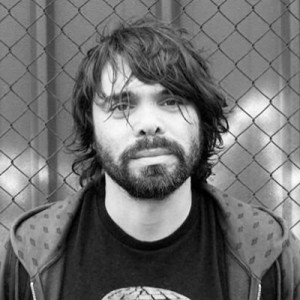 Are there any particular animators/designers/illustrators you would cite as major influences at the beginning of your career, and are they different from those who influence you today?
Are there any particular animators/designers/illustrators you would cite as major influences at the beginning of your career, and are they different from those who influence you today?
All the people who inspired me when I was younger I still love. Animators such as David Anderson, Stuart Hilton, Brad Bird; Illustrators like Bill Sienkiewicz and Bill Watterson. People who really float my boat these days are Jean-Jaques Sempe, Christophe Blain and the never-ending inducer of jaw drops that is Chris Ware.
How did you come to work at StudioAKA initially?
Because they were one of the few companies that offered me a job (bless ‘em). I was originally training to be a Telecine operator but then they called and offered me a job as a runner – a position that I loved.
Before you began work on ‘Stroll’, what were some of the most satisfying projects you worked on/directed at Studio AKA, and for what reasons?
I did a series of small Orange spots for Mother that were so simple and discreet, and had such lovely musical arrangements attached to them — they’ve always been favourites. Unfortunately they’re so simple and discreet that no one’s really bothered about them. Ho hum.
You produced ‘Park Foot Ball’ and ‘Welcome To Glaringly’ during a time when you were working outside of Studio AKA. How did they come about?
I’ve always been repped by AKA, and love working in the studio, but I’m able to work outside of the studio as well, which is healthy. It’s easy when you’re in one place to develop a baby bird attitude and just wait, opened mouthed, for work to be fed to you. It seems to benefit everyone that the work stems from lots of different sources.
I managed to win some funding from Channel 4’s MESH Scheme (now sadly defunct) who already had Blackwatch Productions in place. So I took six months off commercial work to make the film with them.
I quite liked working out of the studio, I met some really interesting people and got offered work that sounded like a lot of fun, like the animated series “Monkey Dust”. I also made “Park Foot Ball” with the help of Onedotzero during that time. After that, MTV asked if I could do a series based around the idea, an undertaking I could not have done without AKA.
Extending the previous question, how did you find working with Onedotzero and Channel 4/Blackwatch respectively?
Blackwatch were great, very hands-off but ultimately supportive. Onedotzero I love, and it’s gutting to see their funding completely cut. When you see institutes like Channel 4 and, in a sense, the BBC reducing their commitment and interest in animation to nothing, Onedotzero seem to be the only people out there championing animation and getting people excited about what’s going on with it today. Long live Onedotzero.
With the ‘LoveSport’ series being one of the campaigns your name is most identified with, ‘Paintballing’ in particular going somewhat viral, what do you suppose were the main elements of these shorts that made them so endearing to a mass audience?
Who knows? I was always amazed that people responded to ‘Park Foot Ball’. So making a series like that seemed nuts. I suppose people like physical comedy, and animators seem to enjoy bringing to life static, seemingly dull objects. So there is some crossover for a relationship between viewer and animator there.
Most of Studio AKA’s output tends to boast a lot of visual creativity and ingenuity that one wouldn’t automatically associate with commercial work. How much free reign are you afforded by your clients when directing commissioned work?
Largely clients come to us because of those reasons. They’re looking to us for a creative response to their brief. There are always parameters, but usually there’s always a joint determination between the agency and us to make it the best job we can.
Some of your earlier projects, such as your work for Compaq, have included some impressive hand-drawn animation. Have your subsequent leanings toward computer animation been a personal choice or are they determined by what’s in demand commercially?
I don’t know … I think there are probably quite a few reasons. Budgets and time are the main ones, as well as demand. Although I’m currently doing a hand-drawn job which doesn’t have a huge schedule, so it’s still viable – it really depends on if it’s necessary or not. I’ve lost the will to be a purist about it anymore though, that can really slow you down.
You’ve mentioned in prior interviews the prospect of a film project produced entirely using watercolours…
That’s a perfect example of me being an arse about technique. I realised that film was going to take me years to make, it would look great but take me years. So I put that to one side to make a film that would only take me a couple of months to complete in XSI and Flash. That ended up taking the company and me two years to finish. So much for being pragmatic…
When you work for a company such as Studio AKA who are mainly known – or sought after – for their commercial work, what are the circumstances that lead to a short film such as ‘A Morning Stroll’ being produced?
It’s not really a policy, but just a natural inclination to want to make your own work, which has turned into a commitment to creating independent work on a regular basis. It comes to a point where you can’t expect creative work to turn up at your doorstep without exhibiting genuinely new creative work of your own.
Were you faced with a greater number of challenges and responsibilities being at the helm of this film than previous commercial projects and spots you’d directed?
I suppose it was a different set up to commissioned work. AKA were keen to do it, but without any funding we could only use people in their downtime. So if someone became available we would shepherd them onto some aspect of the film. Fortunately for the company (but I suppose unfortunately for the film) AKA has been pretty much at full steam on commercial projects for quite a few years. So I was basically getting people for a couple of hours here or there, and that was during my commitment to commercials as well. So I suppose the aspect of the process we struggled with was retaining focus on a short film that was taking two years to make, and not continually changing aspects of it because time was moving on and you naturally like to progress things. Because the production was so strung out, the content of the film had to be really pinned down from the start. You’ll think something is initially funny, then two years down the line the joke is wearing a bit thin. So we had to resist the temptation of trying to jolly it up out of boredom and have faith that what we liked about it initially would come across to people viewing it for the first time.
Were there any disasters or setbacks during the production?
Not much, apart from I got ill for about eight months. That was a bummer. Got that cleared up and AKA were fantastic through it. So all in all it went pretty smoothly considering.
It’s been brought up that the story of the film is partially based on a true story. What was it about the story that inspired you to make a film out of it?
I read a book that was edited by Paul Auster called ‘True Tales of American Life’. Basically, the book is a collection of very short, real life events submitted by lots of different people, and the very first story is of a woman who sees a chicken walk down a street, stop at a door and knock to be let in. That’s it. It really tickled me, and raised lots of questions such as “Who trains a chicken to go for a walk?”, “Where had the chicken come from?”, “Why had the woman who remembered the story retell it years later?”. It was really slight and inconsequential yet got me thinking about it because of its brevity and lack of information. So the film isn’t about that story, it’s about all the stuff that doesn’t appear in the story.
I would assume, without giving too much away, that over the course of the film the faithfulness to the original text dwindles. What was behind the more drastic changes and set pieces, as well as the decision to retell the story over three different eras?
Again it was riffing on that original, simple idea. Overcomplicating something unnecessarily can be funny right? Also I like the old adage: Repeat until funny. Plus I’m greedy and wanted to do it in three different styles.
The film starts off somewhat innocuously and winds up taking some pretty dark and unexpected turns toward the end, a quality shared by some of the ‘LoveSports’ pieces and ‘Welcome To Glaringly’. Have you always tended to gravitate toward dark humour in your work?
I don’t think so. I’ve never really thought about it before. Maybe I’m a bit of a closet drama queen and like a showy ending. Basically it’s a big flounce out of the room at the end of a party.
In pieces such as the ‘LoveSports’ series, you’ve been able to imbue very simplistic designs and geometric shapes with instantly identifiable character traits, through the use of sound and timing in lieu of facial acting or body language. Do you find that the comparatively traditional character animation of ‘Stroll’ proved to be more or less of a challenge when conveying personality and emotion?
I suppose they both have their challenges, but I consider the techniques to achieve these to be exactly the same. I’m essentially a 2D animator and learning all that involved animating the old sack test – which I imagine most 2D animators have had to do it at some point – to animating Tony the Tiger. All these things use the same principles; it’s just a difference in detail.
This film is, in some respects, more visually adventurous and layered than a lot of your earlier work yet at the same time managing to retain elements of the contemporary, somewhat-minimalist style you’ve been known for. Was it hard to strike that balance of style progression and artistic identifiability?
A lot of the style was pre-determined by the first section of the film. As we repeat the story with the same layout and camera moves three times, the last two sections are just a case of different ways of colouring in. So the rules assigned to the job dictated the style. I think that’s the same with a lot of my work, I set down a series of rules and then the style is formed from that. So deciding I’m just using cubes with no details as in the case of ‘Park Foot Ball’ pretty much designs itself.
One particularly nice bit of foreshadowing in the film involves a very well-observed, (presumably) fictional interactive phone app. Given the increasingly sophisticated nature of cross-platform interactive media and its creative/cultural potential, do Studio AKA have any plans down the line for that type of product?
I worked with a guy called Kevin Meredith on interactive projects about ten years ago, but there was no money in it and computer speeds weren’t really able to achieve what you really wanted. So we gave it up. Now with iPhones and iPads there’s a perfect platform for it and with apps there’s potential to get some revenue for it. We didn’t miss the boat; we just waited for it far too early and then got bored waiting, walked off and then the boat turned up…the bugger.
How satisfied are you with the finished film? Did it exceed any expectations or come out more or less as you’d hoped?
I can never tell whether a film or a job is any good, I get far too familiar with it and far too insecure about it. So when ‘A Morning Stroll’ was premiered at Annecy and went down really well I relaxed a little. I love making these films, but I hate showing them to people.
Which practitioners (other directors/studios etc) in the animation world do you feel are doing the most to move the medium forward?
Oh boy. There’s a lot of people I like. I don’t know about moving it forward, but there’s an awful lot of people keeping it vibrant. A couple of films I’ve seen recently really floated my boat. ‘Dimanche/Sunday’ ( vimeo.com/21137303 ) by a Canadian guy called Patrick DOYON (blog.doiion.com/ ). And the work of a guy called Joseph Pelling ( www.josephpelling.co.uk ) has really made me happy recently, ‘The Lost Coin’ (www.josephpelling.co.uk/815962/The-Lost-Coin ) especially.
What future projects lined up are you most excited about, and are they work-based or independent?
I’m working on a new short film at the moment called ‘First Class’, and I’m hopefully going to work on another short film project with über-talented designer Chris Gray. Fun fun.
“A Morning Stroll” won the Junior Jury Award as its Annecy premiere last month and has is continuing to be received well on the festival circuit, picking up multiple awards including Best Animation at the Brooklyn Film Festival, the Wimbledon Shorts Animation Award and Special Prize at the Merveilleux Festival of Film. More information on Grant’s work as well as Studio AKA’s past, present and future projects can be found at studioaka.co.uk


